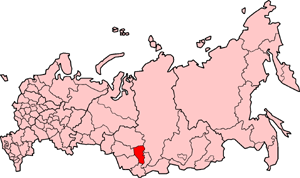
Ulyanovskaya Mine disaster
Encyclopedia

Methane
Methane is a chemical compound with the chemical formula . It is the simplest alkane, the principal component of natural gas, and probably the most abundant organic compound on earth. The relative abundance of methane makes it an attractive fuel...
explosion
Explosion
An explosion is a rapid increase in volume and release of energy in an extreme manner, usually with the generation of high temperatures and the release of gases. An explosion creates a shock wave. If the shock wave is a supersonic detonation, then the source of the blast is called a "high explosive"...
that occurred on March 19, 2007 in the Ulyanovskaya longwall
Longwall mining
Longwall mining is a form of underground coal mining where a long wall of coal is mined in a single slice . The longwall panel is typically 3–4 km long and 250–400 m wide....
coal mine in the Kemerovo Oblast
Kemerovo Oblast
Kemerovo Oblast , also known as Kuzbass after the Kuznetsk Basin, is a federal subject of Russia , located in southwestern Siberia, where the West Siberian Plain meets the South Siberian mountains...
. At least 108 people were reported to have been killed by the blast, which occurred at a depth of about 270 meters (885 feet) at 10:19 local time (3:19 GMT). The mine disaster was Russia
Russia
Russia or , officially known as both Russia and the Russian Federation , is a country in northern Eurasia. It is a federal semi-presidential republic, comprising 83 federal subjects...
's deadliest in more than a decade.
Kemerovo Oblast governor Aman Tuleyev
Aman Tuleyev
Aman Gumirovich Tuleyev , born 13 May 1944, is the governor of Kemerovo Oblast. He ran for President of Russia in 1991, 1996 and 2000, both times coming fourth....
said that when the blast occurred, "the mine was preparing to launch "Eighteen" an advanced mining safety system developed in the UK. The system signaled a sudden discharge of a large amount of methane and caving at 14:30 local time." According to the Russian Prosecutor General's office
Prosecutor General of Russia
The Prosecutor General of Russia heads the system of official prosecution in courts known as the Office of the Prosecutor General of Russian Federation ....
, "the explosion occurred when equipment was being tested". The explosive agent is thought to have been either methane
Methane
Methane is a chemical compound with the chemical formula . It is the simplest alkane, the principal component of natural gas, and probably the most abundant organic compound on earth. The relative abundance of methane makes it an attractive fuel...
or coal dust
Coal dust
Coal dust is a fine powdered form of coal, which is created by the crushing, grinding, or pulverizing of coal. Because of the brittle nature of coal, coal dust can be created during mining, transportation, or by mechanically handling coal.-Explosions:...
, both of which are highly susceptible to spontaneous combustion. The main theory for the cause of the explosion is that it resulted from "a breach of mining safety". However, the mine operator has denied any connection between the explosion and the new equipment.
Among the dead was a British mining consultant, Ian Robertson, who worked for the Anglo-German company International Mining Consultancy. According to Russian sources, the company was involved in auditing the mine's coal reserves. He was accompanied by most of the mine's senior management, who had gone underground shortly before the explosion; the entire party was caught in the blast. The audit was reportedly being conducted in conjunction with the mine operator's planned initial public offering
Initial public offering
An initial public offering or stock market launch, is the first sale of stock by a private company to the public. It can be used by either small or large companies to raise expansion capital and become publicly traded enterprises...
of stock shares to obtain cash for a $700 million investment programme.
The operator of the mine is Yuzhkuzbassugol ("South Kuzbass Coal"), a half-owned associate of the Evraz Group
Evraz Group
Evraz Group is one of the world's biggest vertically integrated steel production and mining businesses, with operations mainly in Russia. In 2008, Evraz Group produced 17.7 million tonnes of crude steel.-Overview:...
conglomerate, which is Russia's largest producer of deep-mined coal. The mine, which opened in 2002, is one of the newest pits in the Kuzbass coal-mining region of Siberia
Siberia
Siberia is an extensive region constituting almost all of Northern Asia. Comprising the central and eastern portion of the Russian Federation, it was part of the Soviet Union from its beginning, as its predecessor states, the Tsardom of Russia and the Russian Empire, conquered it during the 16th...
, with modern equipment made in the UK and Germany. It has been producing at an annual rate of about 1.5 million tonnes of coking coal concentrate
Coke (fuel)
Coke is the solid carbonaceous material derived from destructive distillation of low-ash, low-sulfur bituminous coal. Cokes from coal are grey, hard, and porous. While coke can be formed naturally, the commonly used form is man-made.- History :...
.
In the aftermath of the accident it was revealed that the mine had suffered "problems with equipment safety rules". It was also announced that 60 coal mines in the surrounding area were to be inspected for similar violations soon after the disaster, and that the entirety of the nation's mines would be inspected during the coming weeks.
Preliminary findings from the Ulyanovskaya investigation found that safety equipment had been tampered with deliberately to decrease the readings of methane levels in the mine. According to Governor Tulayev, this was done "consciously in order to increase coal production". Five mine inspectors were subsequently dismissed for allowing the mine operator to "breach safety rules in order to make a profit." The blast was said to have been caused by sparks from an exposed cable igniting methane gas, which then ignited coal dust.

